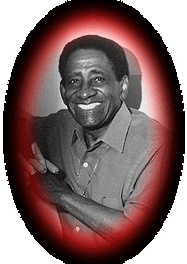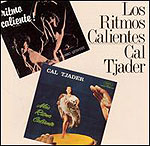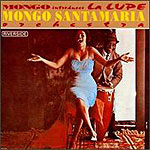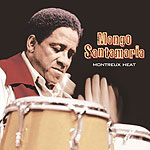
|
||
| Volume II, Issue I | Spring 2003 | |
| Spring 2003 Home Page |
| Culture, Politics & Technology |
| Fiction |
| Music |
| Poetry |
| Theater / Drama |
| About / Contact |
| Archive |
| Current Home Page |
Mongo Santamaria
Books are longer now, mostly incomprehensible, pointless. Music mechanical, metallic, eerie. Daily existence a mill of electronic, opaque esoterica. Skyscrapers are tombstones and love comes in plastic packages. You can't even get your shoes shined without going to a major metropolitan airport.
 Mongo Santamaria, circa 1995 |
The wooden rim punishes, the unyielding hide stings - lessons in pain. Like the great Greek god of the culinary arts demands the apprentices catch scalding pots with their bare hands before they are allowed to stir the ingredients.
|
Few have been blessed with the gift and granted leave to cultivate and grasp the power of the Conga so thoroughly as Ramon "Mongo" Santamaria, who on Feb. 1 departed for the celestial spheres after 85 years on the earth beat.
I experienced the baptism of Conga power in the mighty hands of Armando Peraza when he was with Carlos Santana. A concert at the San Diego State University amphitheater in the early 1980s, with Santana still trying to be a rock-and-roll star. Peraza took over the show for five minutes of percussive fireworks that shook the stadium down to its infrastructure, conjuring up the elements, and I heard the voices of the Ancient Chorus transmitted in a Morse Code of fiery tongues.
Several months later, I had the good fortune to catch Mongo live with his wonderful band of Latin-jazz maestros at a Chinese restaurant and now I know it was no coincidence that he shared this extraordinary ability with Armando. They shared the bond of friendship, their art forged in Cuba, the cauldron of the great congeros, where the sons of slaves preserved the languages of rhythm handed down from generation to generation of Africans.
Mongo and Armando traveled to New York together in 1950, each to later follow his own path and establish his own legendary identity within the context of the jazz and Latin realms, and both contributing greatly to the unification of the two idioms, a process that had been going on throughout the century, accelerated with the emergence of their compatriot Chano Pozo with Dizzy Gillespie's bands and the band leader Machito's collaborations with Charlie Parker and other beboppers.
Mongo unflinchingly tackled every sort of gig available to a congero and flourished, rather than confining himself to mambos and rhumba bands. He became popular among various jazz leaders covetous of the Latin tinge, most notably the San Franciso vibist Cal Tjader, with whom he recorded the now-classic Latin jazz album, "Mas Ritmo Caliente."
By 1960, Santamaria was leading his own Latin band in the Bay area and doing albums for Fantasy, one of which, "Yambu," offered listeners a slice of authentic Afro-Cuban street music. Curiously, Mongo reshaped his band into a tight, ferociously driving Latin-jazz unit, largely dispensing with vocals and creating a platform for explosive jazz improvisation performed by young, up-and-coming jazz artists like Chick Corea and Hubert Laws. Several of the pieces were modern jazz masterpieces, such as Santamaria's own composition, "Afro Blue," later employed so effectively by John Coltrane. Much of it was lighter fare inflected with happy grooves and the soul-jazz idiom of the day.
By quirk of fate, Mongo was introduced to Herbie Hancock and his tune "Watermelon Man," which Mongo injected with an infectious groove spiking the jaunty melody and in the process creating one of the few post-big band era jazz tunes to become a pop hit. The name Mongo Santamaria had entered the mass public consciousness practically though most knew little about him beyond his association with "Watermelon Man" - the ineluctable modality of the audible.
But to Mongo, it didn't matter if it was a 12-bar blues or a 16-bar turn-around, it was all pretty much window dressing. He could play anything, creating a remarkable free-flowing torrent of cross-rhythms, tap-dancing hands tattooing a percussive tapestry on your eardrums.
And he kept it going until near the end. Thankfully Pablo Records, now a division of Mongo's first label, Fantasy, had the good sense to re-release his ensemble's performance at 1980 Montreaux and let me tell you the stuff is popping.
Until the end, Mongo asserted Cuba was the core and the inspiration and I couldn't help but think back to when I was sittin' on the hood of Mirna's Pinto at Griffith Park ... the drums were grooving, the Bacardi limbering us up and embracing us in the evening breezes and I got my arm around her. A couple fellows were improvising a flute and trumpet duet and these two cats wearing lucumi beads from a downtown brujeria started dancing in unison, so smooth and subtle, each move rippling with the rhythm and Mirna says with her Bronx, P.R., accent, "Those Cubans, man, check it out" and I say "What about the Cubans" and she says "I don't know man but they're always so down with it. I think it's something like, that's where the music came from, at least that's what they tell me. You know what, I think I better get back on the pill or we better use something ... I'm very fertile ..."
Juega, Mongo. Que chevere!
![]()
Spring 2003 Music Section | Spring 2003 Main Page
Current Music Section | Current Home Page
Copyright ©
Reprinted by permission of author, who retains all copyright and control.


